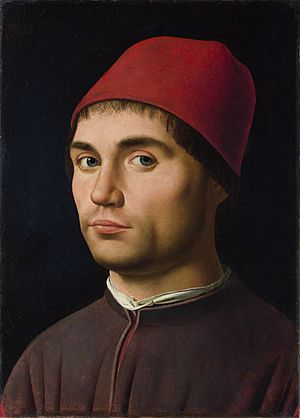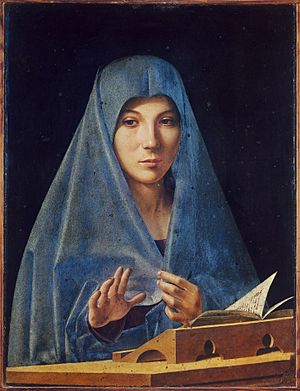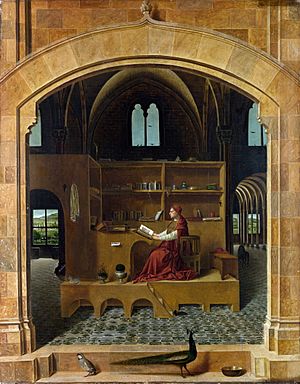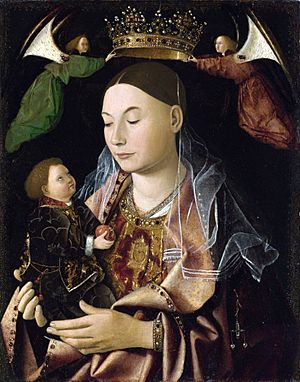Antonello da Messina facts for kids
Quick facts for kids
Antonello da Messina
|
|
|---|---|

Portrait of Man, possibly a self-portrait
|
|
| Born |
Antonello di Giovanni di Antonio
c. 1430 |
| Died | February 1479 (aged 48–49) Messina, Kingdom of Sicily
|
| Nationality | Italian |
| Known for | Painting |
| Movement | Italian Renaissance |
Antonello da Messina (born around 1430, died February 1479) was an important Italian painter. His full name was Antonello di Giovanni di Antonio. He was active during the Early Italian Renaissance.
Antonello was from Messina, a city in Sicily. His paintings were greatly influenced by Early Netherlandish painting, which came from artists in the Netherlands. Some people, like the famous writer Giorgio Vasari, believed he was the first to bring oil painting to Italy. However, this idea is now debated. What makes Antonello special is that his art influenced painters in northern Italy, especially in Venice, even though he was from the south.
Contents
Biography
Early Life and Training
Antonello was born in Messina between 1429 and 1431. His parents were Garita and Giovanni de Antonio Mazonus, who was a sculptor. His father taught him art when he was young.
It is thought that Antonello learned painting in Rome. Then he went to Naples. At that time, paintings from the Netherlands were very popular in Naples. A letter from 1524 says that Antonello was a student of the painter Niccolò Colantonio in Naples around 1450. Most art experts agree with this idea about his training.
Starting His Career
Antonello went back to Messina from Naples in the 1450s. Around 1455, he painted the Sibiu Crucifixion. This painting was inspired by how Flemish artists painted the same subject. Another painting, a Crucifixion in Antwerp, is from the same time.
These early works show a strong Flemish influence. This is because of his teacher Colantonio. It also comes from paintings by Rogier van der Weyden and Jan van Eyck. These paintings belonged to Colantonio's patron, Alfonso V of Aragon.
The writer Giorgio Vasari said that Antonello saw an oil painting by Van Eyck in Naples. This painting belonged to King Alfonso V. Vasari believed Antonello then brought oil painting to Italy.
New information suggests that an "Antonello di Sicilia" (meaning 'from Sicily') met Petrus Christus in Milan in early 1456. Christus was a very skilled follower of Van Eyck. It is likely this was Antonello da Messina. This meeting could explain why Antonello was one of the first Italian artists to master oil painting like Van Eyck. It also explains why Christus was the first Dutch painter to learn linear perspective from Italy.
Antonello's paintings after this time show tiny details. They also show how light falls on different objects. This style is very similar to the Dutch masters. This suggests that Christus might have taught Antonello in person. Also, the calm faces and peaceful feeling in Antonello's paintings seem to come from Dutch art. He is thought to have shared Van Eyck's painting methods with Gentile and Giovanni Bellini.
Between 1456 and 1457, Antonello became a master painter in Messina. He even shared his home with a student named Paolo di Ciacio. In 1457, Antonello received his first known art job. He was asked to paint a banner for a group called the Confraternità di San Michele dei Gerbini in Reggio Calabria. He set up a workshop there to make banners and religious pictures. By this time, he was already married and had a son named Jacobello.
In 1460, his father rented a small boat to bring Antonello and his family back from Amantea in Calabria. In that same year, Antonello painted the Salting Madonna. This painting mixes traditional religious art with Flemish style. It also shows more attention to the shapes of the figures. This might mean he knew about the works of Piero della Francesca.
Also from around 1460 are two small paintings. They show Abraham Served by the Angels and St. Jerome Penitent. These are now in the Museo Nazionale della Magna Grecia in Reggio Calabria. In 1461, Antonello's younger brother Giordano joined his workshop. He signed a three-year agreement. That year, Antonello painted a Madonna with Child for a nobleman in Messina, but this painting is now lost.
Historians believe Antonello painted his first portraits in the late 1460s. These portraits followed a Netherlandish style. The person was shown from the chest up, against a dark background. They faced forward or slightly to the side. Before this, most Italian painters showed people from the side, like on a medal. John Pope-Hennessy said Antonello was "the first Italian painter for whom the individual portrait was an art form in its own right."

Antonello is mentioned in many documents between 1460 and 1465. These show he was in Messina during those years. However, there is a gap in the records between 1465 and 1471. This suggests he might have spent these years on the mainland of Italy. In 1474, he painted the Annunciation, which is now in Syracuse. The painting St. Jerome in His Study is also from around this time.
Time in Venice
Antonello traveled to Venice in 1475 and stayed there until the autumn of 1476. His paintings from this time show more focus on the human body. He paid attention to how people's bodies were built and how they showed feelings. This shows the influence of artists like Piero della Francesca and Giovanni Bellini.
Some of his most famous paintings from this period include the Condottiero (in the Louvre museum), the San Cassiano Altarpiece, and St. Sebastian. The San Cassiano Altarpiece was very important for painters in Venice. It was one of the first large paintings in the sacra conversazione style. This style was later made perfect by Giovanni Bellini. The part of Antonello's work that still exists in Vienna is only a small piece of a much larger original painting.
It is also likely that Antonello taught Giovanni Bellini and other Venetian painters how to use oil paints. He also shared his ideas about keeping faces calm and compositions peaceful in paintings. While in Venice, he was offered a job as the court portrait painter for the Duke of Milan, but he did not accept it.
Return to Messina and Death
Antonello returned to Sicily by September 1476. Paintings from near the end of his life include the famous Virgin Annunciate. This painting is now in the Palazzo Abatellis in Palermo. Another work from this time is the San Gregorio Polyptych.
Antonello died in Messina in 1479. His will is dated February of that year. Records show he was no longer alive two months later. Some of his last paintings were not finished. His son Jacobello completed them.
Style and Legacy
Antonello's painting style is special because it combines the simple beauty of Italian art with the detailed focus of Flemish art. He had a huge impact on Italian painting. He not only introduced Flemish ideas but also shared Flemish techniques. However, no specific school of painting formed after his death, except for the Sicilian artist Marco Costanzo.
Selected Works
- Sibiu Crucifixion (1455) - Muzeul de Artà, Bucharest
- Abraham Served by the Angels - Museo della Magna Grecia, Reggio Calabria
- Portrait of a Man (1460s) - Oil on wood, Civic Museums, Pavia
- Ecce Homo (around 1470) - Tempera and oil on panel, Metropolitan Museum of Art, New York City
- Ecce Homo (1470) - Tempera and oil on panel, Galleria Nazionale di Palazzo Spinola, Genoa
- St. Jerome Penitent - Various techniques on wood, Museo della Magna Grecia, Reggio Calabria
- San Gregorio Polyptych (1473) - Tempera on panel, Regional Museum, Messina
- Ecce Homo (around 1473) - Tempera on panel, Private collection, New York City
- Portrait of a Man (1474) - Oil on wood, Staatliche Museen, Berlin
- Madonna with Child (Salting Madonna) - Oil on wood, National Gallery, London
- Portrait of a Man (1474) - Oil on wood, Staatliche Museen, Berlin
- Annunciation (1474) - Oil on panel, Bellomo Palace Regional Gallery, Syracuse
- St. Jerome in His Study (around 1474) - Oil on wood, National Gallery, London
- Ecce Homo (1475) - Oil on panel, Collegio Alberoni, Piacenza
- Portrait of a Man (Il Condottiere) (1475) - Oil on wood, Musée du Louvre, Paris
- Crucifixion (1455) - Oil on panel, Koninklijk Museum voor Schone Kunsten, Antwerp
- Crucifixion (1475) - Wood, National Gallery, London
- Portrait of a Man (around 1475) - Oil on wood, Galleria Borghese, Rome
- Portrait of a Man (around 1475) - Oil on panel, National Gallery, London
- Portrait of a Man (1475–1476) - Oil on panel, Museo Thyssen-Bornemisza, Madrid
- San Cassiano Altarpiece (1475–76) - Oil on panel, Kunsthistorisches Museum, Vienna
- The Dead Christ Supported by an Angel (1475–78) - Panel, Museo del Prado, Madrid
- Christ at the Column (around 1475–1479) - Oil on wood, Musée du Louvre, Paris
- Virgin of the Annunciation - Oil on panel, Alte Pinakothek, Munich
- Portrait of a Man (1476) - Oil on panel, Museo Civico d'Arte Antica, Turin
- Virgin of the Annunciation (around 1476) - Oil on wood, Museo Nazionale, Palermo
- St. Sebastian (1477–1479) - Oil on canvas, Gemäldegalerie Alte Meister, Dresden
- Portrait of a Young Man (around 1478) - Panel, Staatliche Museeun, Berlin
- Portrait of an unknown man - Oil on panel, Museo Mandralisca, Cefalù
- Madonna and Child - Oil and tempera on panel, National Gallery of Art, Washington, D.C.
Images for kids
See also
 In Spanish: Antonello da Messina para niños
In Spanish: Antonello da Messina para niños








